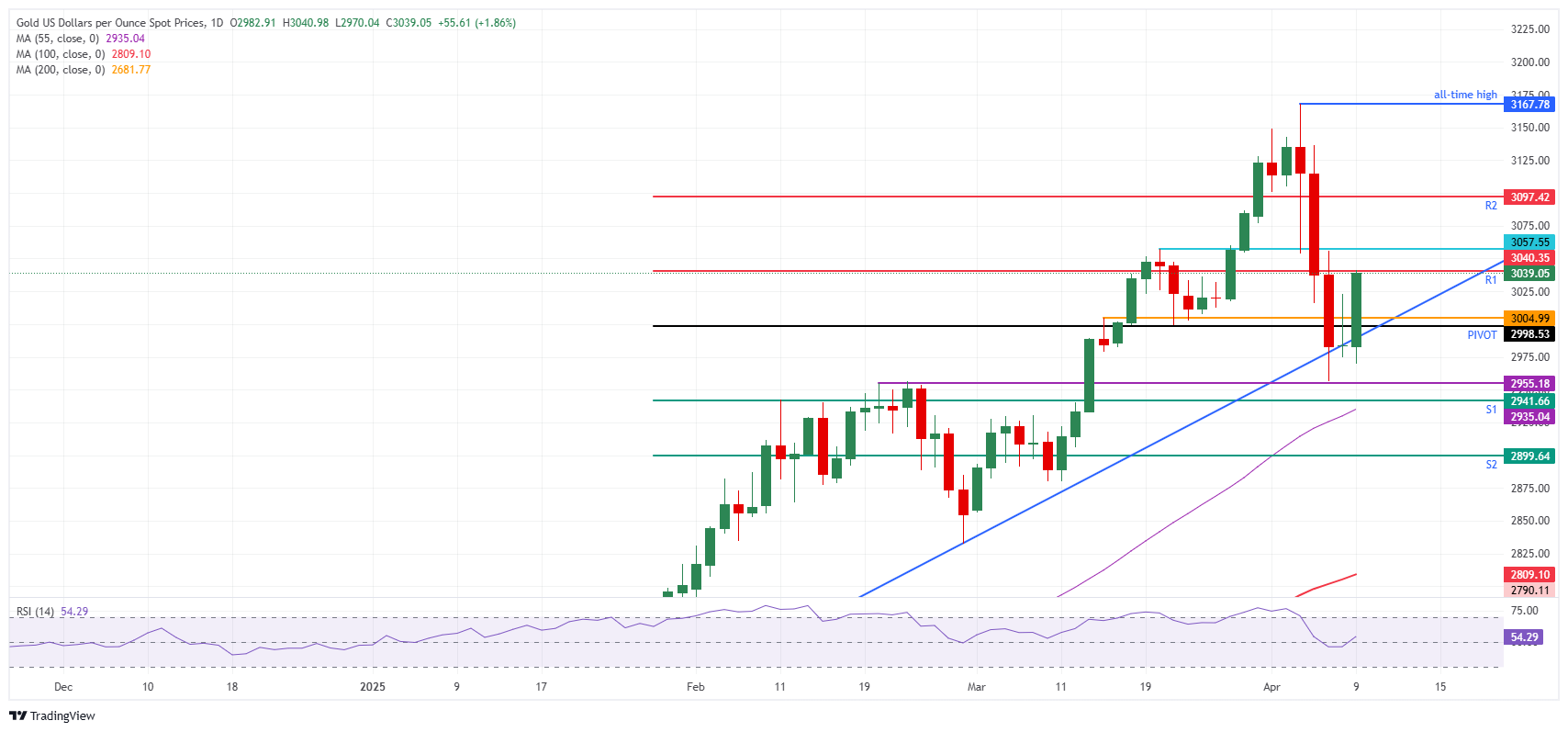Gold price jumps with US tariffs and China’s countermeasures in place

- Gold price jumps over 2% on Wednesday with US tariffs being switched on.
- Risk-off mood and rising bets of Fed rate cuts amid recession fears also benefit Gold.
- Gold bounces from the sub-$3,000 region to just below $3,050 at the time of writing.
Gold price (XAU/USD) bounces higher and recovers to $3,045 at the time of writing on Wednesday after United States (US) President Donald Trump’s tariffs came into effect. At one point this week, markets were hoping for a last-minute solution as several news outlets informed on Monday that President Trump was considering a 90-day pause in tariffs for all countries except China. However, the White House stated that any suggestion that President Trump was considering a 90-day pause in tariffs was “fake news.”
“Gold’s rebound reflects growing investor anxiety over tariff threats and the potential reshaping of global trade norms,” says Christopher Wong, a foreign currency strategist at Oversea-Chinese Banking Corp. Bullion remains a good hedge against a more disorderly global economy, Wong said, Bloomberg reports. The market also speculates that heightened volatility may prompt the Federal Reserve (Fed) to speed up interest rate cuts to prevent a recession. Lower rates typically benefit Gold, which doesn’t pay interest.
Halfway through the European trading session, headlines emerge that China is retaliating against the US imposed tariffs. Chinese Finance Minister Lan Fo’an said an additional 84% of tariffs will be imposed on all US goods. The tariffs will take place as of April 10th.
Daily digest market movers: Fed tied up
- Shares of Muthoot Finance, an Indian financial corporation and the largest Gold loan non-bank financial company in the country, declined as much as 6.3% after the Indian central bank said it would undertake a comprehensive review of gold loan regulations, which could potentially increase competition in the sector.
- The CME FedWatch tool shows the chance of an interest rate cut by the Federal Reserve (Fed) in May’s meeting surging to 53.5%, compared with only 10.6% a week ago. For June, the chances of lower borrowing costs are 100%, with 55.2% anticipating a 50 basis point (bp) rate cut.
- Chinese investors funneled a record amount of cash into Gold-backed Exchange Traded Funds (ETFs) last week, drawn by the asset’s safety as combative trade war rhetoric from the world’s biggest economies shakes global markets. Inflows to four major onshore Gold ETFs, including Huaan Yifu Gold ETF, hit a record of 7.6 billion yuan ($1 billion) last week, according to Bloomberg’s calculations, with strong inflows continuing this week, Bloomberg reports.
- Later this Wednesday, around 18:00 GMT, the Federal Open Market Committee (FOMC) will release its latest Minutes from the rate decision meeting in March.
Gold Price Technical Analysis: Back to square one
With the US tariffs taking effect this Wednesday, the markets’ reaction is one still with some surprise. It seems that markets were positioned for some last-minute solution or delay, which would soften the actual blow and impact of the tariffs. Nonetheless, duties are taking effect immediately, and that is enough for last-minute investors to head back into Gold.
Looking up, resistances are a bit spread out, with the first cap of the R1 resistance at $3,041 being tested when writing, followed by $3,057, a pivotal level since March 20. Further up, the R2 resistance at $3,089 precedes the current all-time high of $3,167.
On the downside, the pivotal level of the March 14 high at $3,004 roughly coincides with the $3,000 round number. If this area does not hold as support, bears can target the S1 support at $2,964 and the $2,955 level, where clearly many buyers were interested in scooping up Gold on Monday. Further down, the S2 support at $2,945 is the last line of defense before the 55-day Simple Moving Average (SMA) at $2,935.
XAU/USD: Daily Chart
Tariffs FAQs
Tariffs are customs duties levied on certain merchandise imports or a category of products. Tariffs are designed to help local producers and manufacturers be more competitive in the market by providing a price advantage over similar goods that can be imported. Tariffs are widely used as tools of protectionism, along with trade barriers and import quotas.
Although tariffs and taxes both generate government revenue to fund public goods and services, they have several distinctions. Tariffs are prepaid at the port of entry, while taxes are paid at the time of purchase. Taxes are imposed on individual taxpayers and businesses, while tariffs are paid by importers.
There are two schools of thought among economists regarding the usage of tariffs. While some argue that tariffs are necessary to protect domestic industries and address trade imbalances, others see them as a harmful tool that could potentially drive prices higher over the long term and lead to a damaging trade war by encouraging tit-for-tat tariffs.
During the run-up to the presidential election in November 2024, Donald Trump made it clear that he intends to use tariffs to support the US economy and American producers. In 2024, Mexico, China and Canada accounted for 42% of total US imports. In this period, Mexico stood out as the top exporter with $466.6 billion, according to the US Census Bureau. Hence, Trump wants to focus on these three nations when imposing tariffs. He also plans to use the revenue generated through tariffs to lower personal income taxes.
